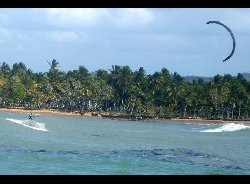
Kite
By Anne-Sylvaine Chassany
April 18 (Bloomberg) -- On a windy day in 1985, Bruno Legaignoux jumped into the ocean off France's Brittany coast with a homemade kite harnessed to his waist and skis on his feet, letting the wind pull him across the water.
Then, suddenly, a gust of wind lifted the 24-year-old inventor into the air, before dropping him back down and sending him skimming over the waves. Kiteboarding was born.
``It took me by surprise,'' recalled Bruno, now 47 and a millionaire. ``I realized the sport had potential. It was fun.''
Now kiteboarders outnumber windsurfers on beaches from Hawaii to Corsica and a professional circuit is sponsoring 10 events in 2008. This week, more than 50 kiteboarders are competing at Mondial du Vent in Leucate, France, where 19-year- old Briton Aaron Hadlow is defending his freestyle championship.
The kiteboarding boom has made Bruno and his brother, Dominique, wealthy after they patented their kite designs. Now they are in talks to sell their patents before a new technology makes theirs obsolete.
``The patent can be questioned by counterfeiters at any moment and a new type of more-advanced sail can be invented from one day to the next,'' said Bruno, who like his brother lives in the Dominican Republic. ``I prefer selling quickly and getting it over with.''
The sale could earn the brothers at least 2 million euros ($3.2 million), said Pierre Veron, a patent lawyer in Paris.
Legal Battles
Once seen as an extreme sport, about 80,000 kiteboarders are certified each year by the International Kiteboarding Organization, based in the Dominican Republic. Fifty brands of kites have popped up, and U.S. windsurfing star Robby Naish, who founded his eponymous company, has developed his own technology.
A cross between paragliding and windsurfing, kiteboarding uses large sail-like kites to propel the riders, who take short flights as they jump above the water.
``It\'s a good time to sell,\'\' said Stan Bresson, a spokesman for Montpellier, France-based kite maker Takoon. ``With the market now growing and technology progressing fast, competition and patent infringers exert more pressure. Bruno has spent more time on legal battles than on research lately.\'\'
The brothers declined to discuss the sale negotiations and said they have no regrets.
``I\'ve made enough money to sail around the world for the rest of my life, my dream,\'\' said Bruno, who dropped out of university at 18 to become a sailing instructor.
`Absolute Freedom\'
For Bruno and Dominique, their creation started with bits of fabric and books on aerodynamics during a sailing trip along the coast of Africa in 1984.
Their first prototype, a 20-centimeter polystyrene model that they tested on Senegal\'s Casamance River, wasn\'t perfect. They realized they needed a kite that would float and could take off on water.
In November of that year, back in France, the two former junior sailing champions applied for a patent on a C-shaped kite with an inflated edge.
Ten years later, their patents were licensed by companies including Hong Kong-based windsurfing gear maker Pryde Group and Hawaii-based Naish.
The brothers get 12 euros a kite from equipment makers. More than two-thirds of the world\'s kiteboarding kites use some element of their safety-enhancing ``bow\'\' technology, according to a 2006 survey by SBC Kiteboard Magazine. The concave structure with a bridle is designed to release most of the wind in case of a gust.
As many as 120,000 kites were sold last year and the market should grow 15 percent annually as technology becomes safer, said Michael Raper, operations manager of Pryde\'s Cabrinha unit, one of the three biggest brands.
``You get a feeling of absolute freedom,\'\' said Maximin Thevoux, a one-time windsurfing instructor who now teaches kiteboarding near Bonifacio, Corsica. ``When you take a jump, you feel light, hanging in the air, with no sense of gravity.


